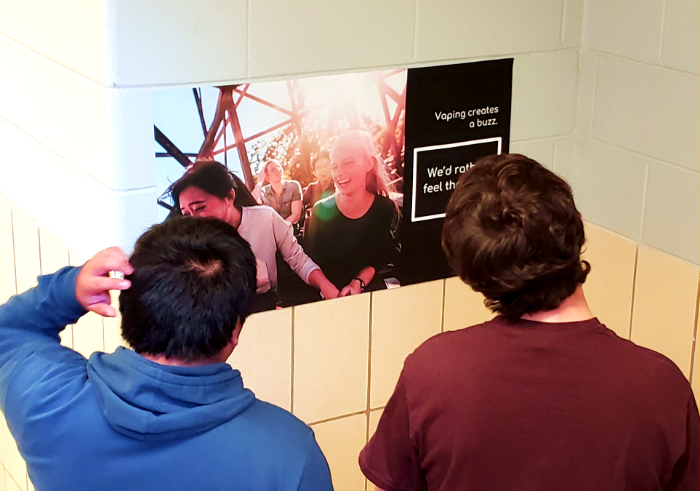Most Teens posters are cute — I’d rather they be useful
More stories from Emmanuelle Copeland
DGS hangs posters in the hallways and stairwells that deter drug use.
The Most Teens posters have come out and you know what that means: Watching middle-aged adults attempt to pick up the lingo of the #coolkids and everyone else cringing a little.
I mean, it’s not that the posters are wrong per se. Only kind of cute and a lot misled.
Most teens our age aren’t dumb. Most can understand the message that drugs are bad for you. It’s been a major focus of our health education since the fourth grade when a police officer showed you bloody, cancer-filled gums in the middle of a quirky slideshow and told you you’re “too cool for drugs” via pencil.
Fast-forward many years later and these posters are those pencils.
Now don’t get me wrong, I love puns. It probably makes up a solid 95% of my sense of humor and is a masterful use of a language’s nuances. Puns are fun, and those that pretend not to enjoy them are just trying to feel superior by acting all “groan” up.
As always the wordplay is pretty “endearing” in this situation, which is to say entirely forgettable. If a pun could deter people from using drugs, no one would be using drugs.
Here’s an example: You say, “Alcohol lowers inhibitions, I’d rather be brave.”
Great job. You’ve successfully pointed out that some people compensate for low self-esteem by self-medicating through drugs. Please attempt to do absolutely anything with that information.
Low-self esteem is absolutely a factor in the rates of drug usage. But if you’ve identified that, how are you going to build their self-worth back up? What resources are you showing the users? What support systems have you directed them to? Most teen users can probably tell you that it’s better to feel like you don’t need drugs. So what ways are you helping them improve their thinking? Answer: You’re not.
These posters have simply given users one more reason to feel isolated when your message is simply that they are the minority of the school population and have sub-par confidence, and you know it.
Now let’s say the target audience was never users and that it was actually the student population that has yet to experiment or yet to have gotten addicted to drugs.
The posters still completely ignore the complex systems of racial, socioeconomic and social dynamics which influence a kid’s cultural background and thus decision making. They have not given them a way to navigate social situations. They have also failed to deliver them to any support systems or sense of community that need to be maintained in order to deny such pressures on their own.
Now it’s not that the school doesn’t have some solid resources related to drugs and alcohol.
There are some people in the social services department that have been working wholeheartedly on this issue for years and care about students.
Every student has both a counselor and in-school psychologist or social worker assigned to them.
There is a District 99 assistance program which has “A Resource Guide for Families: Raising Healthy Teens” which outlines both legal and social consequences of student drug activity and provides parents ways to teach their children the resources and strategies of avoiding drugs and maintaining solid support systems, while encouraging the parent to have honest discussions and be a solid resource of information and comfort themselves for their child.
All these aren’t very popularly used either because students don’t feel comfortable seeking them out alone or they don’t know they exist.
But there are ways to fix this issue. Namely, letting the people know, maybe even through a poster.
Having counter-messaging to explain how cigarette and alcohol companies market to teenagers, describing the immediate consequences of drug use, referring students to resources to get help for addiction, and referring students to resources to help get them involved in community activities and engaged in student life are all things that the posters should do.
Being cute is not one of them.


